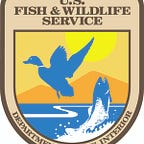INVASIVE SPECIES AWARENESS WEEK
No Bull(frog): These Guys are Bad News
Even if his name is Jeremiah, he’s NOT a good friend of mine
You might be familiar with and even like these frogs. But these amicable amphibians are anything but harmless. Did you know one female bullfrog can produce between 10,000 to 20,000 eggs per year? This large, prolific frog grows quickly and eats almost anything. Bullfrogs out-compete other native amphibians, reptiles and other species for food and shelter. Although native to eastern and central U.S., bullfrogs are an invasive species in the Western United States and are harmful to the ecosystem because of their large appetites. We are joining forces with our partners like the Washington Invasive Species Council to spread knowledge and stop the spread of invasive species like the American bullfrog. Keep reading and find out how you can join the fight!
What Is It?
The bullfrog is the largest frog species in North America. It is found in a variety of freshwater habitats, including ponds, marshes, streams, rivers, canals, reservoirs, ditches, shallow wetlands, and stormwater ponds. Bullfrogs compete with, and prey on, a wide range of native species, and may affect significantly native ecosystems such as wetlands.
Is It Here Yet?
Yes. The bullfrog is found throughout the lowlands of Washington. It entered the state through the aquarium and pet trades, and possibly via release after being used in science classes.
Why Should I Care?
Bullfrogs are predators that eat practically anything they can catch. They can swallow tree frogs, other amphibians and reptiles such as the western pond turtle, minnows, small birds, and young snakes. Introduced bullfrogs have been blamed for native species declines in much of North America.
How Can We Stop It?
Do not buy or share bullfrogs at any life stage (from eggs to adults). Do not release unwanted pet frogs to the wild. Bullfrogs are classified as a Prohibited Aquatic Animal Species in Washington, meaning they may not be possessed, purchased, sold, propagated, transported, or released into state waters. In Washington, bullfrogs only may be caught or killed by angling, hand dip netting, spearing (gigging), or with bow and arrow.
To learn more about what to do with unwanted pets, see our “Don’t Let it Loose” campaign page.
What Are Its Characteristics?
- Egg masses are black on top and white underneath. They start as a round, basketball-size mass that flattens over time.
- Tadpoles are dark green with black dots, have orange or bronze eyes and opaque yellow underbellies, and are up to 6 inches long.
- Juveniles are green to brown with small black spots, orange or bronze eyes, and a fold of skin from the eye around the eardrum.
- Adults are 7–8 inches, with large, exposed eardrums the size of their eyes, and are green, tan, or dark brown with dark spots and gold eyes.
How Do I Distinguish It From Native Species?
Native green and bronze frogs have two parallel lines of raised glandular skin between the back and sides; the bullfrog does not have these features. African clawed frogs may be distinguished in that native frogs tend to only inhabit water to breed, otherwise living on land, but near water. Native frogs are smaller, rougher-textured, and less plump-looking than African clawed frogs. Look up native species (Pacific treefrogs, red-legged frogs, Columbia spotted frogs, Oregon spotted frogs, Cascade frogs) for individual distinguishing details.
A Note for Nerds — Taxonomy conundrum?
Is the American bullfrog Rana catesbeiana or Lithobates catesbeianus? The simple answer is “It’s both!” In taxonomic terms, Rana catesbeiana = Lithobates catesbeianus because both scientific names have been assigned to the same species. Learn more about it here.
Thanks for leaping into action to spread the knowledge, not the invasives. For more info, check out these excellent resources:
- https://nas.er.usgs.gov/queries/FactSheet.aspx?speciesID=71 (USGS Nuisance Aquatic Species Profile)
- http://www.iucngisd.org/gisd/species.php?sc=80 (Global Invasive Species Database)
- Washington Invasive Species Council (learn more about invasives and report sightings)
